Welcome to South Lake Tahoe, one of the premier bird-watching destinations in the United States. From the iconic bald eagle to the colorful waterfowl, South Lake Tahoe has a diverse array of bird species to explore.
With more than 200 species of birds of all shapes and sizes, South Lake Tahoe is a bird watcher’s paradise. From the shorelines of the lake to the higher elevations of the surrounding mountains, visitors to South Lake Tahoe can find a wide variety of bird species.
Whether you’re looking to observe birds in their natural habitat or to take part in a guided bird-watching tour, South Lake Tahoe has something for everyone.
1. Bald Eagle
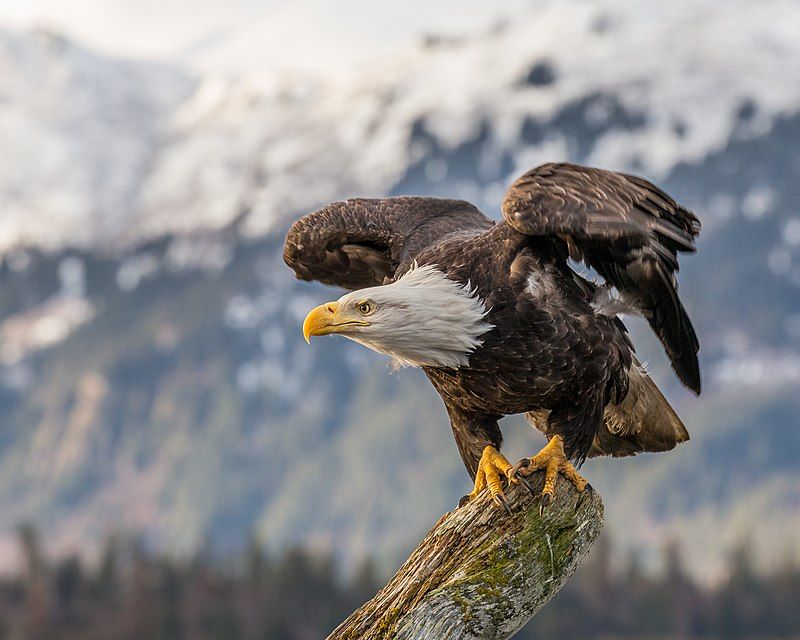
The bald eagle is a large, powerful bird of prey native to North America. It is a sea eagle and has two different subspecies recognized. Its closest relative is the white-tailed eagle, which is found in the Palearctic region.
The two species occupy the same ecological niche, meaning they often compete for the same food and habitat. The bald eagle is easily recognizable due to its distinctive white head and tail feathers, which contrast with its dark brown body.
It has a wingspan of up to 8 feet and can weigh up to 14 pounds. Its diet consists mainly of fish, but it will also feed on small animals and carrion. The bald eagle was once an endangered species, due to human activities such as hunting and habitat destruction.
Fortunately, the species has made a comeback in recent years, with populations increasing due to conservation efforts. Today, it is a symbol of strength and freedom in the United States and is the national bird of the United States of America.
| Kingdom | Animalia |
| Phylum | Chordata |
| Class | Aves |
| Order | Accipitriformes |
| Family | Accipitridae |
| Genus | Haliaeetus |
| Species | H. leucocephalus |
2. Steller’s Jay
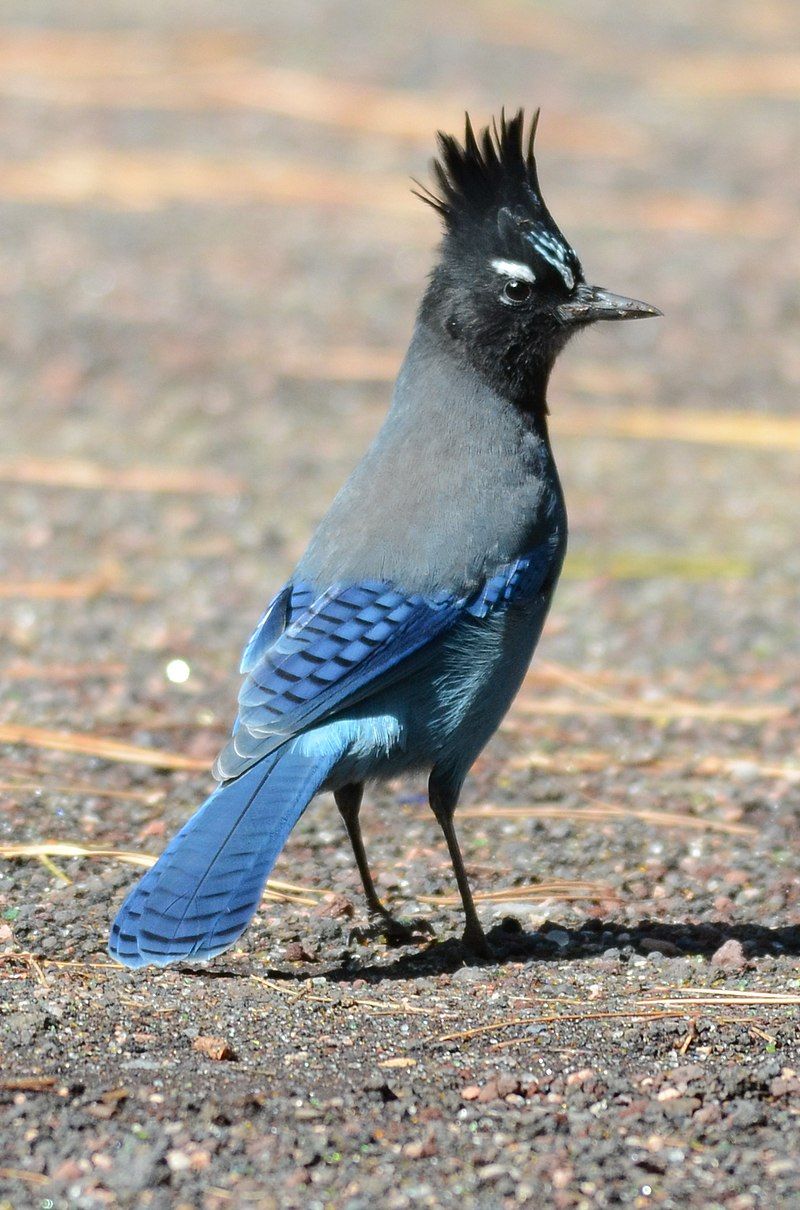
Steller’s jay is a bird species that is native to two regions of North America. It is found in western North America and the mountains of Central America. It is closely related to the blue jay, which is found in eastern North America.
This bird is unique in that it is the only species of crested jay found west of the Rocky Mountains. Steller’s jay is characterized by its vibrant colors. Its head, neck, and back are bright blue, and it has a black bill and a black and white breast.
Its wings and tail feathers are also a deep blue. This magnificent bird is a great sight to see and is a favorite among bird watchers. Steller’s jays are omnivorous, meaning they eat both plants and animals. They are often seen foraging in gardens and parks for food.
They also eat nuts, seeds, berries, and other fruits, as well as insects, small lizards, and even eggs from other birds. Steller’s jays are highly adaptable and can live in many different habitats, from woodlands to suburban areas.
They are also highly social and can be seen in flocks of up to 20 birds. Steller’s jay is a fascinating species and is an important part of the North American bird population.
| Kingdom | Animalia |
| Phylum | Chordata |
| Class | Aves |
| Order | Passeriformes |
| Family | Corvidae |
| Genus | Cyanocitta |
| Species | C. stelleri |
3. California Gull
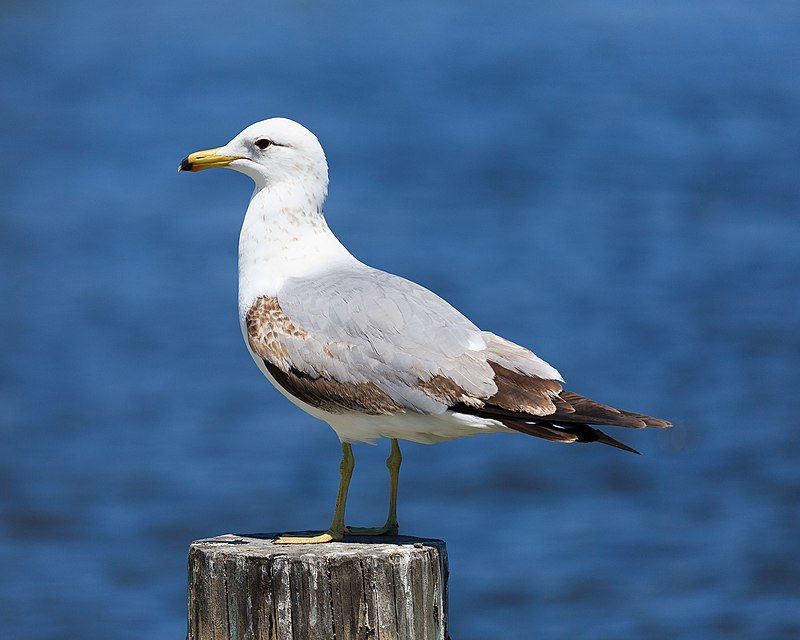
The California Gull is a bird that is found along the Western coast of North America and even has inland breeding grounds. It is a medium-sized gull, larger on average than the Ring-billed Gull, but smaller than the Herring Gull.
Its distinguishing feature is its yellow bill, which has a black ring around the base. This species is a very adaptable bird and can be found in a variety of habitats, including beaches, salt flats, fields, and even urban areas.
It is an omnivorous species, and it eats a wide variety of foods, including plants, small insects, and even other small birds or mammals.
The California Gull is an important species to the local ecosystem, helping to keep populations of small insects, rodents, and other birds in check. Its presence also helps to keep beaches clean, as it scavenges for food that other animals leave behind.
| Kingdom | Animalia |
| Phylum | Chordata |
| Class | Aves |
| Order | Charadriiformes |
| Family | Laridae |
| Genus | Larus |
| Species | L. californicus |
4. Red-Tailed Hawk
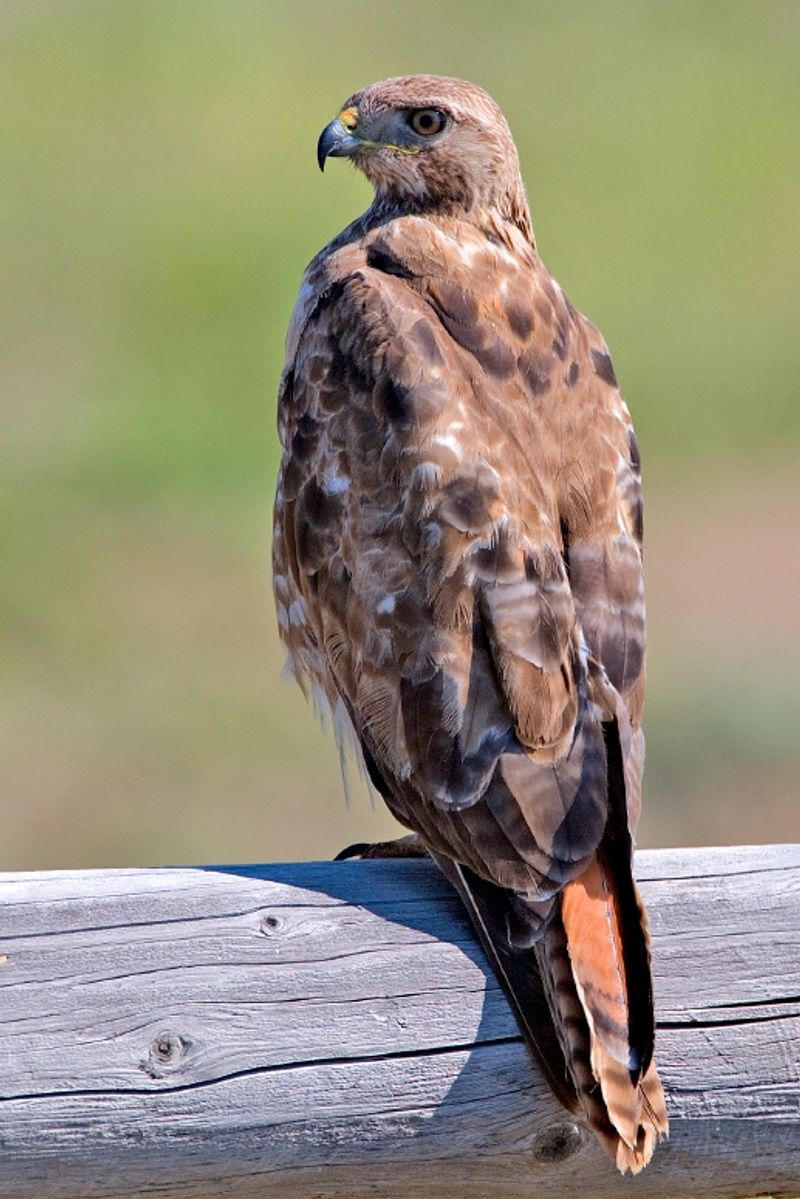
The red-tailed hawk is a bird of prey that is found throughout North America.
It is one of the most widely distributed species within the genus of Buteo and is found in a variety of habitats, from the interior of Alaska and northern Canada, to as far south as Panama and the West Indies.
The red-tailed hawk is an incredibly adaptable species and can be seen living in both urban and rural areas. The red-tailed hawk is a medium-sized raptor, with a wingspan of up to four feet. Its plumage is primarily dark brown, with a distinct reddish-brown tail.
They have a sharp, hooked beak, which they use to hunt and capture small mammals, reptiles, birds, and other creatures. They are often seen soaring through the air, searching for food. The red-tailed hawk is a social species and will often form large nesting colonies.
They typically build their nests in trees, but can also be found nesting on cliffs and other tall structures. The female red-tailed hawk will lay a clutch of three to five eggs, which hatch after around a month.
The male will help feed and protect the young during their first few weeks after hatching. The red-tailed hawk is an important species in North American ecosystems, as it helps to maintain the balance of the food chain.
Their presence also provides an important source of food for other predators. Unfortunately, their numbers have been declining in recent years due to habitat destruction, pesticides, and other human activities.
Conservation efforts are now in place to help protect this species and ensure its long-term survival.
| Kingdom | Animalia |
| Phylum | Chordata |
| Class | Aves |
| Order | Accipitriformes |
| Family | Accipitridae |
| Genus | Buteo |
| Species | B. jamaicensis |
5. Northern Flicker
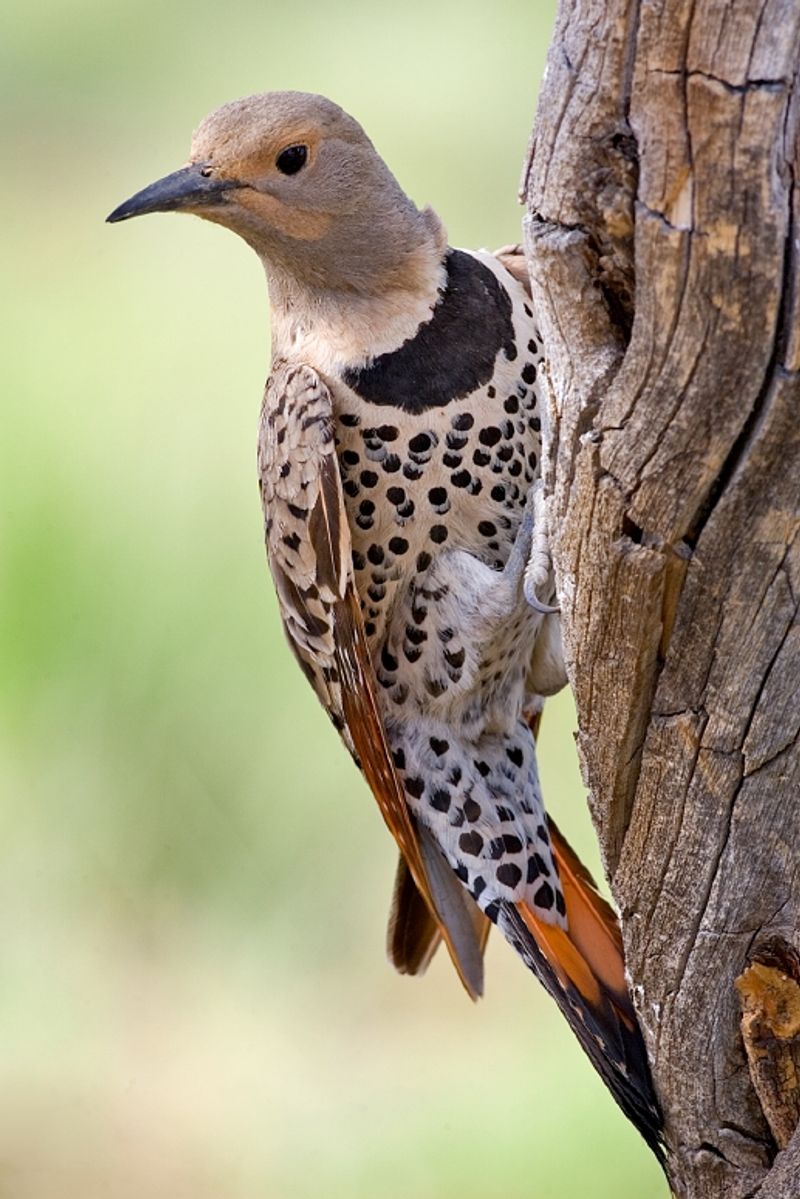
The northern flicker, also known as the common flicker, is an impressive bird of the woodpecker family.
Native to much of North America, as well as parts of Central America, Cuba, and the Cayman Islands, the northern flicker is a medium-sized bird with a strong beak and powerful wings.
Though most woodpecker species remain in one area year-round, the northern flicker is one of the few species that migrate. This bird often travels in flocks, flying south in the winter and north in the summer to find food, shelter, and nesting grounds.
The northern flicker has a unique call – a high-pitched, rolling whistle – that can be heard from far away. The call is distinct and unmistakable, and it is one of the ways in which the northern flicker can be identified.
With its vibrant red and yellow feathers, the northern flicker is a beautiful bird that can be found in wooded areas across North America.
| Kingdom | Animalia |
| Phylum | Chordata |
| Class | Aves |
| Order | Piciformes |
| Family | Picidae |
| Genus | Colaptes |
| Species | C. auratus |
6. Mallard Duck
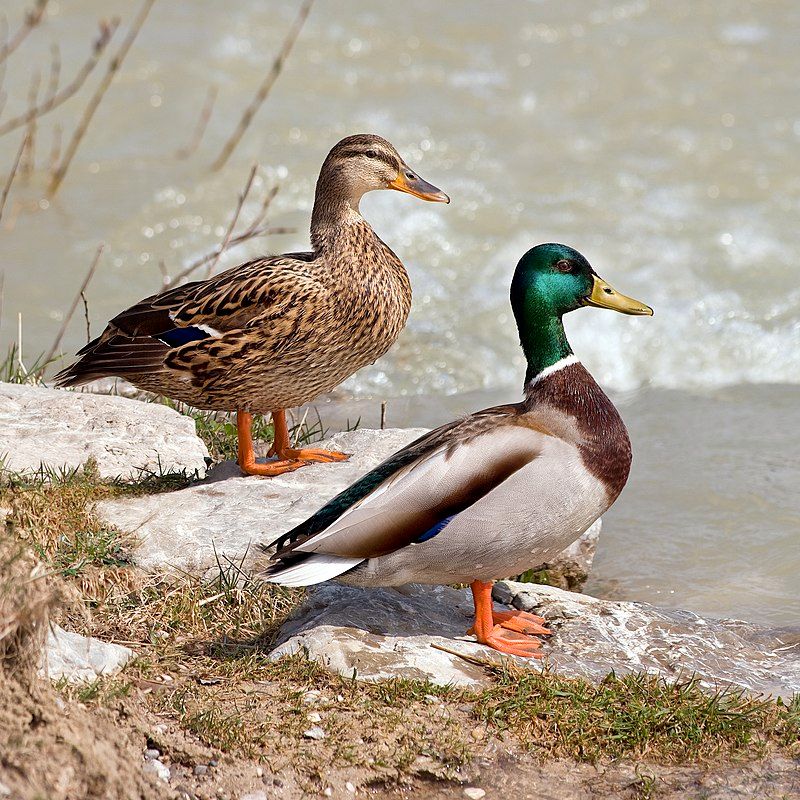
The mallard or wild duck is a species of duck that is found in many parts of the world. It is a dabbling duck, meaning that it feeds near the surface of the water rather than diving deep.
The mallard breeds in temperate and subtropical regions of the Americas, Eurasia, and North Africa. In addition, it has been introduced to New Zealand, Australia, Peru, Brazil, Uruguay, Argentina, Chile, Colombia, the Falkland Islands, and South Africa.
This has been done for a variety of reasons, such as providing additional food sources for humans, providing sport for hunters, and increasing the aesthetic appeal of natural areas.
The mallard is the ancestor of most of the domestic ducks we see today, such as Peking ducks, and has been domesticated for thousands of years. It’s adaptability and wide range make it an incredibly successful species.
| Kingdom | Animalia |
| Phylum | Chordata |
| Class | Aves |
| Order | Anseriformes |
| Family | Anatidae |
| Genus | Anas |
| Species | A. platyrhynchos |
7. Mountain Chickadee

The mountain chickadee is a small songbird, belonging to the family of birds known as Paridae. It is a passerine bird, which is a broad classification for any bird that hops or walks on the ground.
The mountain chickadee is common in the mountainous regions of western North America and is known for its distinctive loud call. Its diet consists mainly of insects, seeds, and berries. It is easily identified by its unique black and white head and bib-like markings.
Its back is a grayish-brown color, while its underparts are white. It can be seen perching on branches and flying around in small flocks. It is a highly social bird, often seen in groups of two or more.
The mountain chickadee is known for its intelligence and has a longer lifespan than other birds in its family. It is also known for its fearlessness, often approaching humans for food.
| Kingdom | Animalia |
| Phylum | Chordata |
| Class | Aves |
| Order | Passeriformes |
| Family | Paridae |
| Genus | Poecile |
| Species | P. gambeli |
8. Least Sandpiper
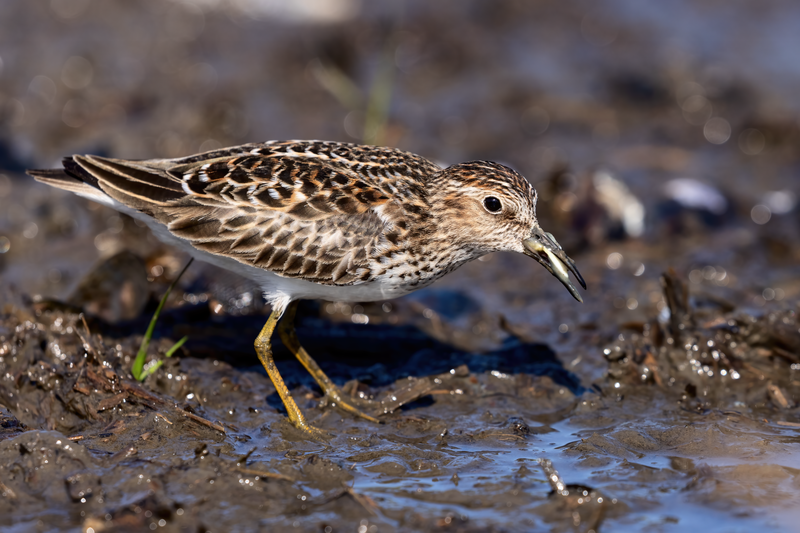
The least sandpiper is an incredibly small shorebird that can be found in many parts of the world. Its scientific name, Calidris minutilla, is a combination of Ancient Greek and Medieval Latin terms.
The genus name, Calidris, is derived from the Ancient Greek word kalidris or skalidris, which was used by Aristotle to describe a type of grey-colored bird that lives near water.
The species name, minutilla, is a Medieval Latin term that translates to “very small.” This aptly describes the minuscule size of the least sandpiper, which is even smaller than some of the other shorebirds that live in the same area.
Its small size, combined with its muted colors, make it difficult to spot among the larger, more brightly colored shorebirds.
| Kingdom | Animalia |
| Phylum | Chordata |
| Class | Aves |
| Order | Charadriiformes |
| Family | Scolopacidae |
| Genus | Calidris |
| Species | C. minutilla |
9. Dark-Eyed Junco
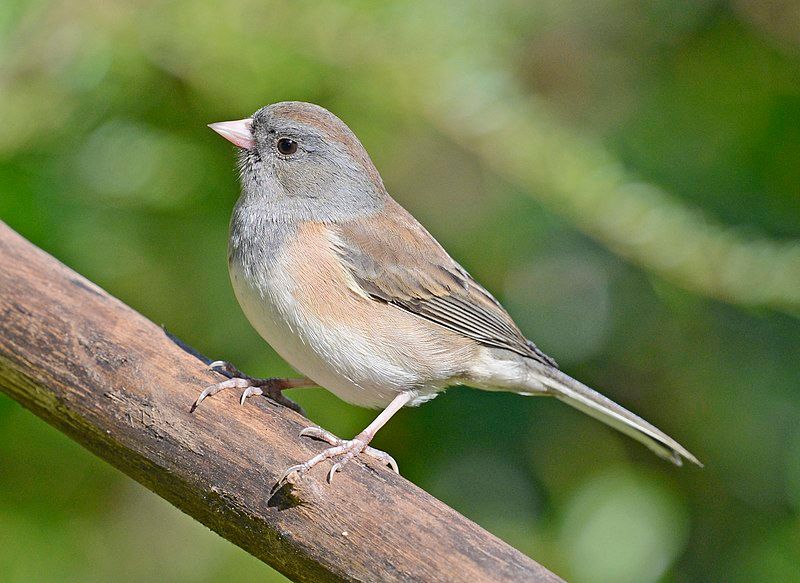
The dark-eyed junco is a type of sparrow native to North America. It is a small bird with gray feathers and is found in many parts of temperate North America.
During summer, it can be found in the Arctic regions, which speaks to its ability to adapt to different types of environments. It is also quite variable, meaning that it can take on different physical characteristics from one individual to the next.
This trait is shared by its close relative, the fox sparrow. Scientists are still working to better understand the taxonomy and relationships between the different species of junco.
| Kingdom | Animalia |
| Phylum | Chordata |
| Class | Aves |
| Order | Passeriformes |
| Family | Passerellidae |
| Genus | Junco |
| Species | J. hyemalis |
10. Golden Eagle
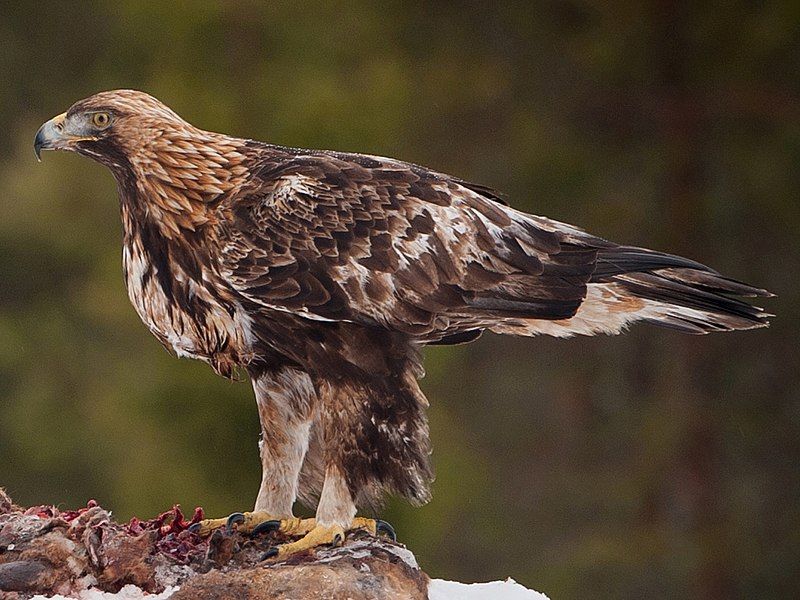
The golden eagle is a majestic bird that is found in various regions of the Northern Hemisphere. It is one of the largest and most widely distributed species of eagle and is recognized for its impressive wingspan which can reach up to 8ft in some cases.
This bird of prey is part of the Accipitridae family and is one of the most easily recognized birds of prey in the Northern Hemisphere. Golden eagles are scavengers and opportunistic predators, meaning they feed on both carrion and live prey.
They mostly hunt small mammals such as rabbits, hares, marmots, and ground squirrels, as well as reptiles and occasionally fish. They also feed on other birds, such as grouse, ptarmigans, and pheasants.
Golden eagles use their powerful talons to grasp their prey and their sharp beaks to tear apart flesh and feathers. Golden eagles are monogamous and tend to form strong pair bonds. They build huge nests on cliff ledges or in tall trees and typically lay one or two eggs per year.
The female incubates the eggs, while the male provides food for her and their young. Golden eagles are considered to be an endangered species and are protected by the Endangered Species Act. As their natural habitats are being destroyed, their populations are declining.
Therefore, it is important to protect these birds and their habitats so that future generations can enjoy their beauty and grace.
| Kingdom | Animalia |
| Phylum | Chordata |
| Class | Aves |
| Order | Accipitriformes |
| Family | Accipitridae |
| Genus | Aquila |
| Species | A. chrysaetos |
11. American Coot
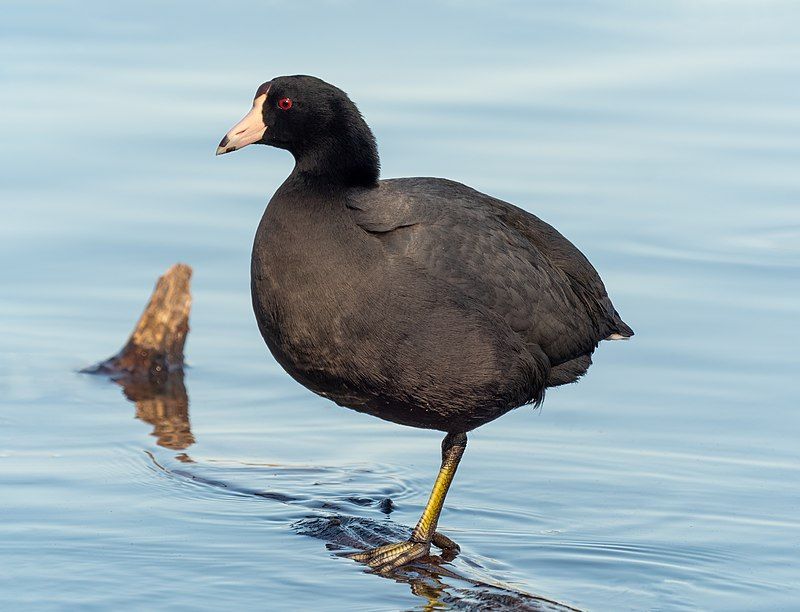
The American coot is a species of bird which is part of the family Rallidae. It is also known as a mud hen or pouldeau. Despite its similarities to ducks, the American coot is only distantly related, belonging to a completely different order.
This is because there are many differences between the two species, such as the size and shape of their bills, the color of their feathers, and the type of habitat they live in. The American coot has a black bill which is typically longer and more curved than that of a duck.
Additionally, the American coot has a more varied range of feather colors, from grey to black, while ducks tend to be mainly brown or white.
The American coot also prefers freshwater environments, while ducks prefer estuaries and salty lakes. These differences between the two species are evidence of how the American coot is only distantly related to ducks.
Despite their similarities, these two species have evolved separately for millions of years, resulting in the differences mentioned above.
| Kingdom | Animalia |
| Phylum | Chordata |
| Class | Aves |
| Order | Gruiformes |
| Family | Rallidae |
| Genus | Fulica |
| Species | F. americana |
12. Tundra Swan
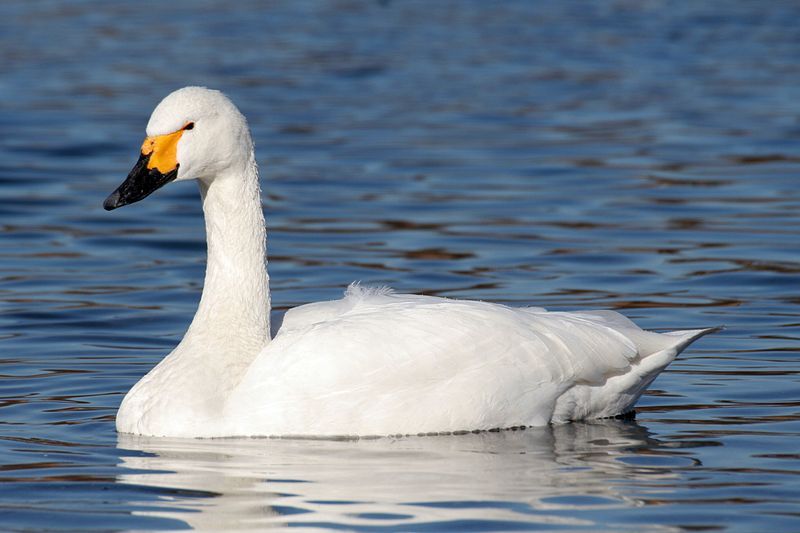
The tundra swan is a species of swan that is found across the Holarctic region, which is the northern part of the globe.
It is divided into two taxa, which are usually regarded as the same species, but at times they may be split into two distinct species known as Bewick’s swan and the whistling swan.
Bewick’s swan is found in the Palaearctic, which is the region of the Northern Hemisphere that comprises Europe, Asia, and North Africa. Meanwhile, the whistling swan is found in the Nearctic, which is the region of the Western Hemisphere that comprises North America.
The two taxa of the tundra swan differ slightly in terms of their size, coloration, and range, but they are both considered to be the same species.
| Kingdom | Animalia |
| Phylum | Chordata |
| Class | Aves |
| Order | Anseriformes |
| Family | Anatidae |
| Genus | Cygnus |
| Species | C. columbianus |
13. Woodpeckers
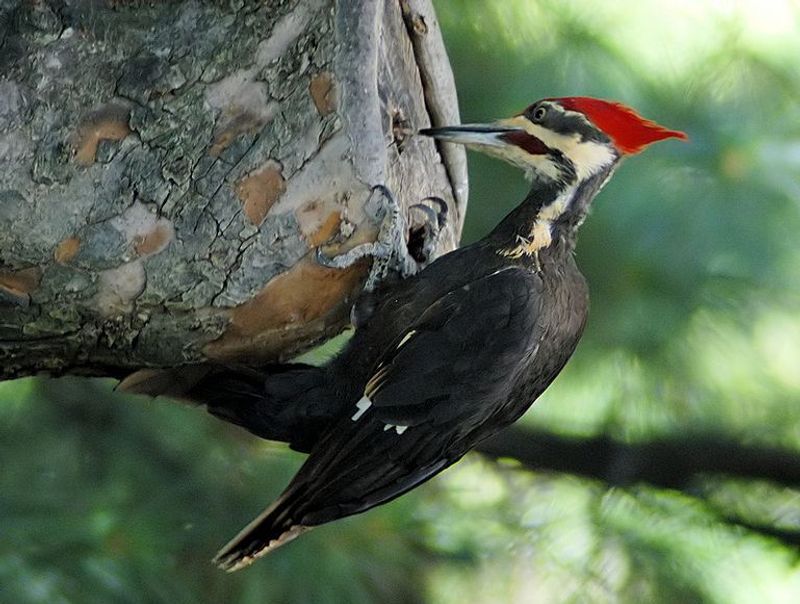
The bird family Picidae consists of woodpeckers, piculets, wrynecks, and sapsuckers. These birds are found in almost every corner of the world, with the exception of Australia, New Guinea, New Zealand, Madagascar, and the extreme polar regions.
This family of birds can vary greatly in size, ranging from the tiny piculets which measure only a few inches in length, to the larger woodpeckers which can grow up to twenty-four inches in length.
Woodpeckers are known for their distinctive chiseling and tapping sounds, which they use to create holes in trees and search for food. They have strong, sharp beaks which they use to peck at the bark of trees and access the insects and larvae that live underneath.
Piculets, wrynecks, and sapsuckers also have strong beaks, but they use them in different ways. Piculets feed mainly on insects and spiders, wrynecks feed on invertebrates and sapsuckers feed on tree sap.
This family of birds is incredibly diverse and provides an important role in the ecosystems they inhabit, helping to keep insect populations in check and providing food for other species.
| Kingdom | Animalia |
| Phylum | Chordata |
| Class | Aves |
| Order | Piciformes |
| Family | Picidae |
14. White-Headed Woodpecker
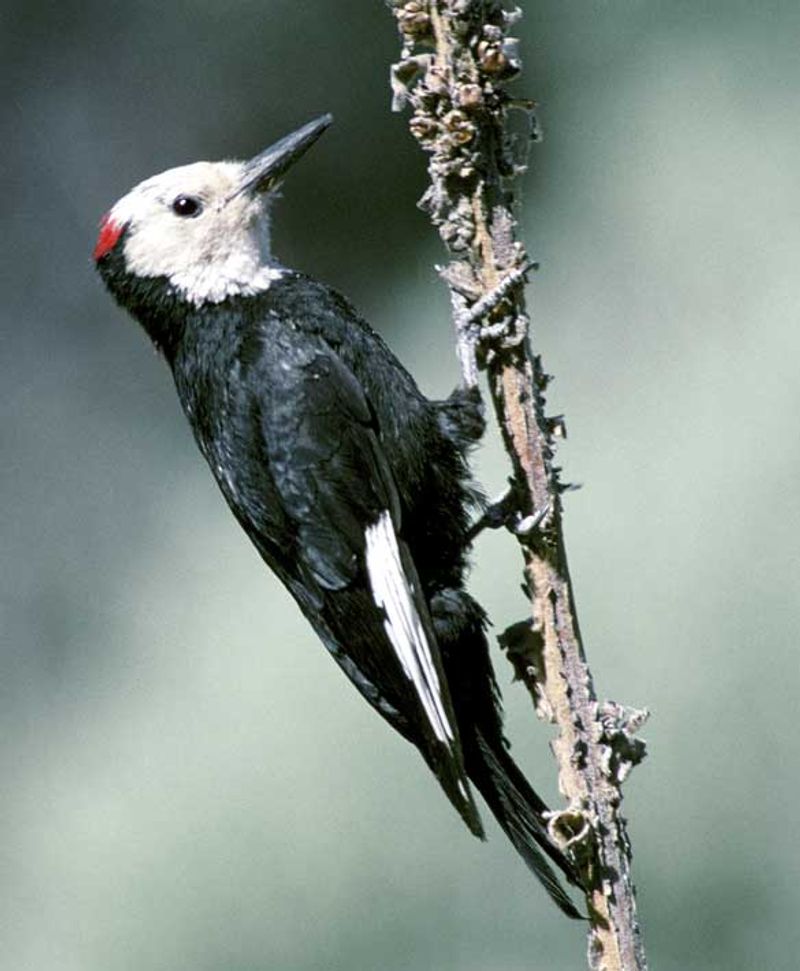
The white-headed woodpecker is a species of woodpecker that is found in the mountains of western North America, primarily in areas of pine forests. It is a non-migratory species, meaning that it stays in the same area year-round and does not travel long distances.
This species has a distinctive white head, which makes it easily identifiable. The body is mainly black, with white stripes on its wings and tail feathers.
It is a medium-sized woodpecker, measuring between 9-11 inches in length. The white-headed woodpecker is an omnivore, meaning it eats both plants and animals. It will feed on a variety of foods, including insects, berries, nuts, and other small creatures.
This species is most commonly found in coniferous and mixed forests, and it prefers open-canopy forests with dead and decaying trees. It will also inhabit areas near streams, lakes, and rivers. The white-headed woodpecker plays an important role in its environment.
It helps maintain healthy forests by excavating cavities and searching for food, which can help create a more diverse habitat. It also disperses seeds and helps control insect populations.
It is an important part of the ecosystem, and its presence helps maintain the balance of the environment.
| Kingdom | Animalia |
| Phylum | Chordata |
| Class | Aves |
| Order | Piciformes |
| Family | Picidae |
| Genus | Leuconotopicus |
| Species | L. albolarvatus |
15. Yellow-Headed Blackbird
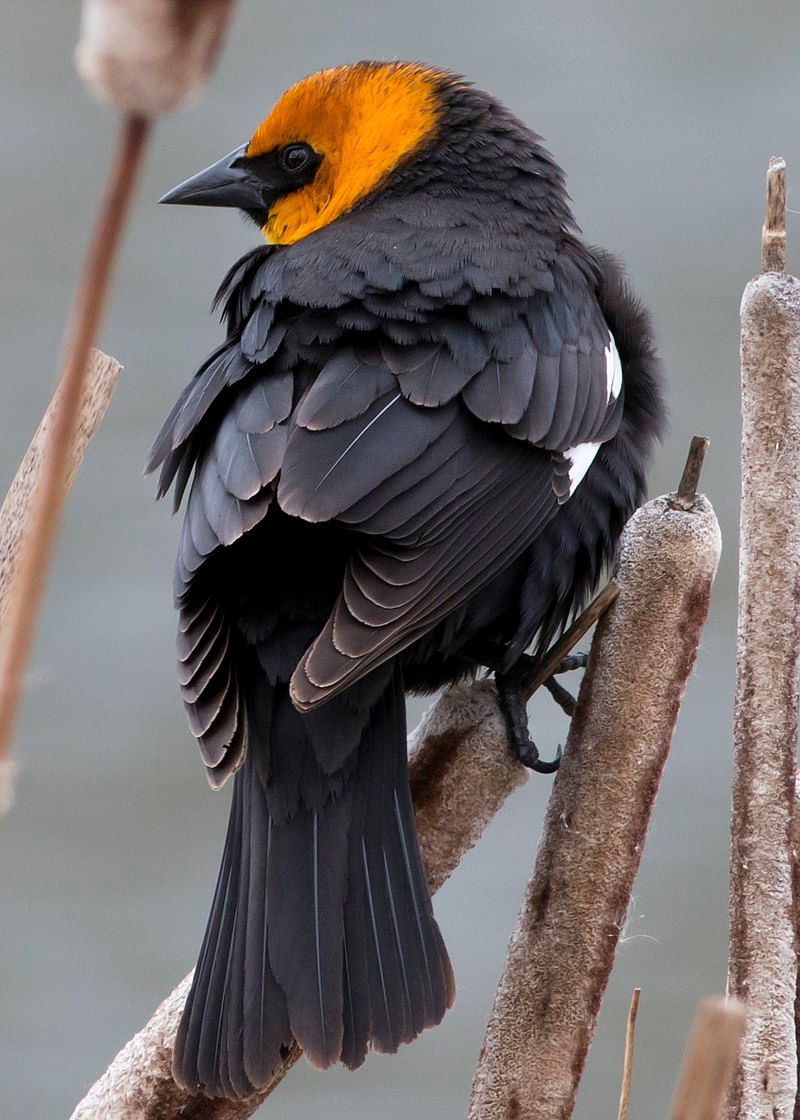
The yellow-headed blackbird is a unique bird found in North and Central America. It is a medium-sized blackbird that stands out from its relatives due to its distinctive yellow head.
It is the only species in the genus Xanthocephalus, which makes it a particularly special bird. The yellow-headed blackbird is usually seen in open habitats such as prairies, meadows, and wetlands. It feeds on insects, berries, and grains, and also visits feeders.
The bird has a unique song that is composed of harsh throaty notes. The main distinguishing feature of the yellow-headed blackbird is its bright yellow head. The bird’s head, neck, and breast are a bright yellow color, while the wings and back are glossy black.
The yellow-headed blackbird is also characterized by its long yellow bill, red eyes, and black legs. The yellow-headed blackbird is a unique species that has its own distinct characteristics.
It is the only bird in the genus Xanthocephalus, and it stands out from its relatives due to its bright yellow head and distinctive song. The yellow-headed blackbird is a fascinating bird to observe and appreciate and is certainly worth looking out for in its natural habitats.
| Kingdom | Animalia |
| Phylum | Chordata |
| Class | Aves |
| Order | Passeriformes |
| Family | Icteridae |
| Genus | Xanthocephalus |
| Species | X. xanthocephalus |
16. Western Tanager
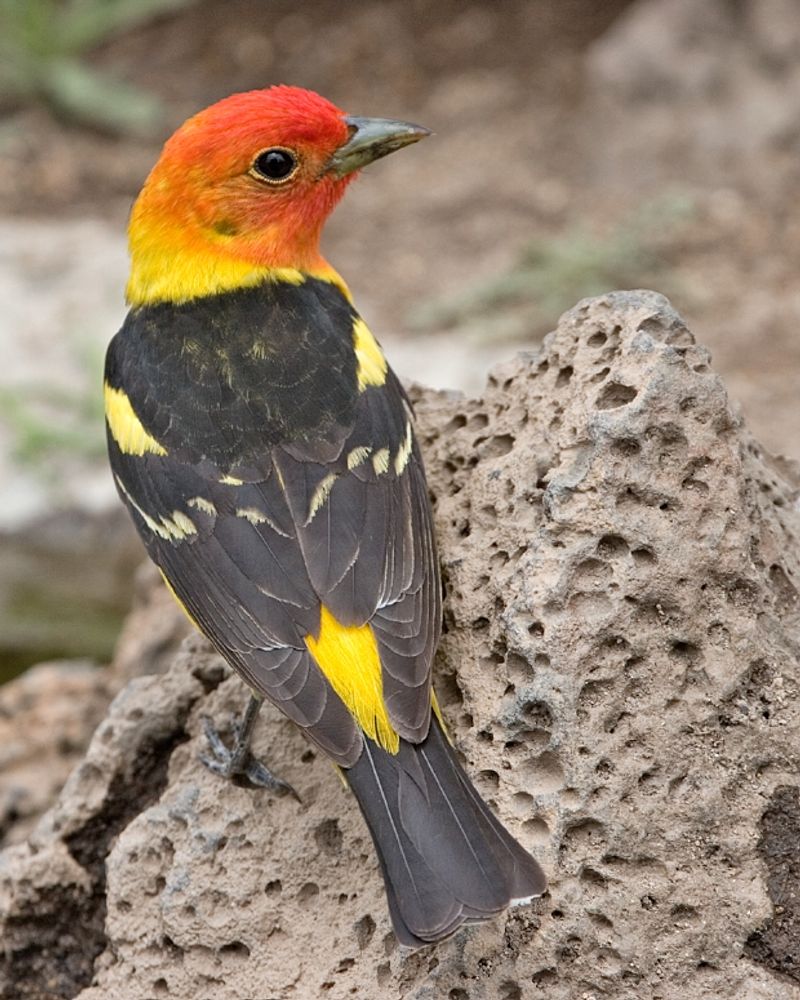
The western tanager is an American songbird of medium size that was formerly placed in the tanager family. However, recent classification has placed it and other members of its genus into the cardinal family.
This is due to the similarities between the western tanager and other members of the cardinal family, such as its plumage and its vocalizations.
The western tanager’s plumage features many colors, including yellow, orange, and red, and its vocalizations are similar to those of other cardinals.
The western tanager is an important bird species in North America, and its inclusion in the cardinal family is an example of how careful research can lead to new classifications of species.
| Kingdom | Animalia |
| Phylum | Chordata |
| Class | Aves |
| Order | Passeriformes |
| Family | Cardinalidae |
| Genus | Piranga |
| Species | P. ludoviciana |
17. Downy Woodpecker
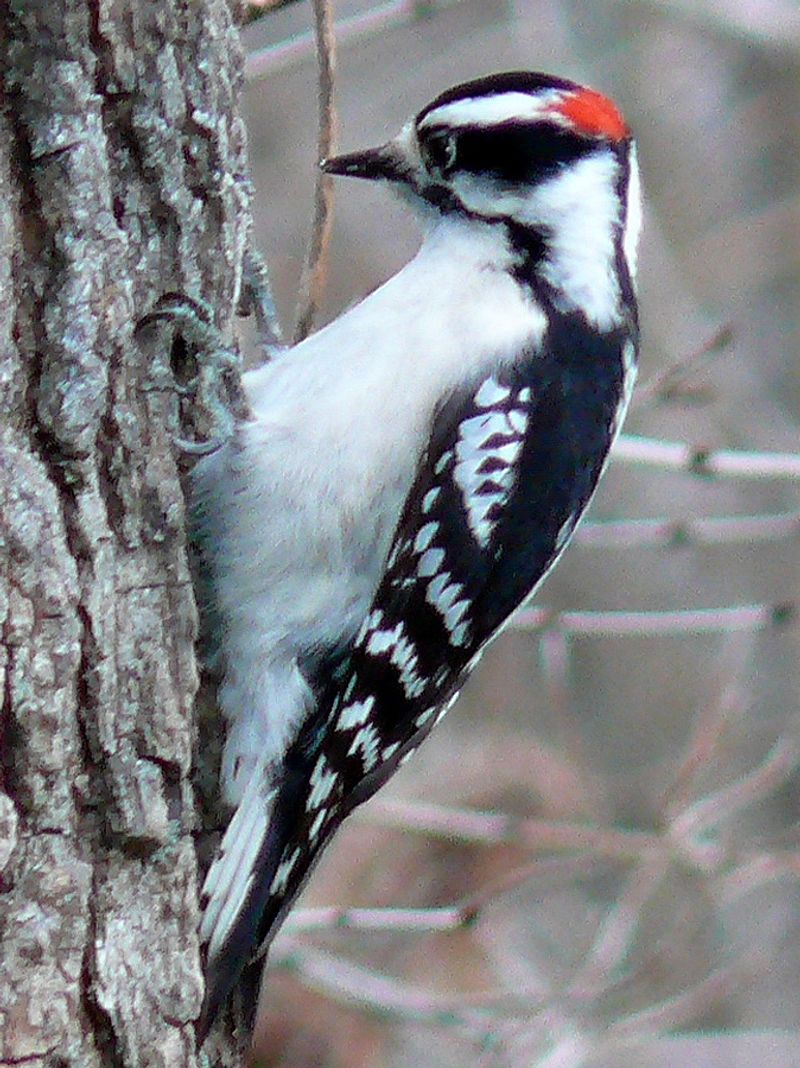
The Downy Woodpecker is a species of bird that is the smallest in North America. It has a length of between 14 and 18 cm.
It is found throughout the United States and Canada, with the exception of the southwestern deserts and the northern tundra.This species of woodpecker primarily lives in forested areas. They are omnivorous, eating both insects and fruits.
The Downy Woodpecker is typically seen flitting among tree limbs and trunks searching for food. They have a unique and distinct call that can often be heard in the forest. The Downy Woodpecker is an important species to the forest eco-system.
They can help to control insect populations, as well as pollinate plants.
They also provide a food source for other animals such as hawks, owls, and snakes. The Downy Woodpecker is a beautiful bird that can be easily identified by its black and white patterned feathers and the red patch on the back of its head.
They are also known to be quite playful and curious, often seen hovering over an area before quickly flying away again. Overall, the Downy Woodpecker is an important species of woodpecker that is found across North America.
It plays a critical role in the forest eco-system and is a beautiful sight to behold.
| Kingdom | Animalia |
| Phylum | Chordata |
| Class | Aves |
| Order | Piciformes |
| Family | Picidae |
| Genus | Dryobates |
| Species | D. pubescens |
18. American Robin
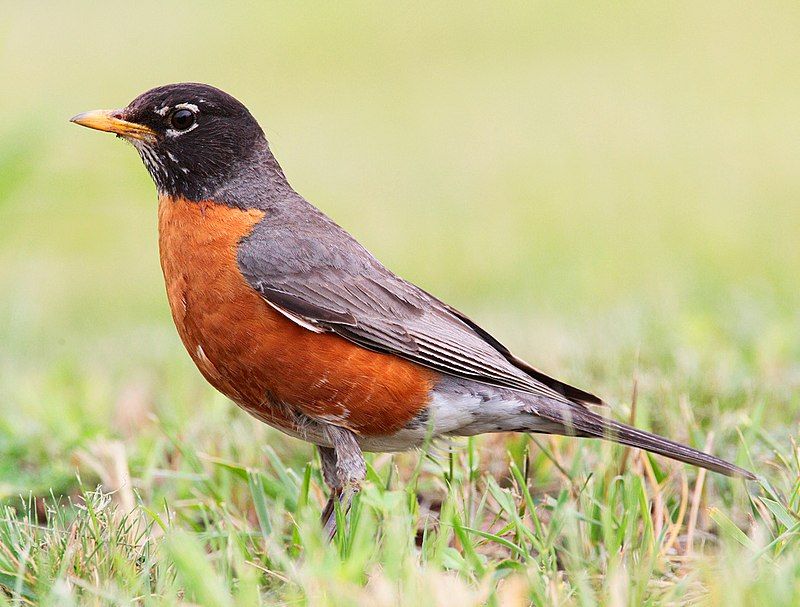
The American robin is a migratory bird belonging to the true thrush genus and the wider thrush family, Turdidae. It is named after the European robin due to its reddish-orange breast, however, the two species are not closely related.
The European robin belongs to the Old World flycatcher family. The American robin is a common sight across North America, with its brown back and head and its bright orange-red breast.
It is often seen near open ground and in urban areas, where it feeds on insects, worms, and fruit. During the winter months, it migrates to warmer climates, although it can still be seen in some areas year-round.
The American robin is an important species for farmers, as it helps to control insect populations and disperse seeds. It is also a beloved bird for many people, who enjoy its melodic song and its cheerful presence.
| Kingdom | Animalia |
| Phylum | Chordata |
| Class | Aves |
| Order | Passeriformes |
| Family | Turdidae |
| Genus | Turdus |
| Species | T. migratorius |
19. Canada Goose
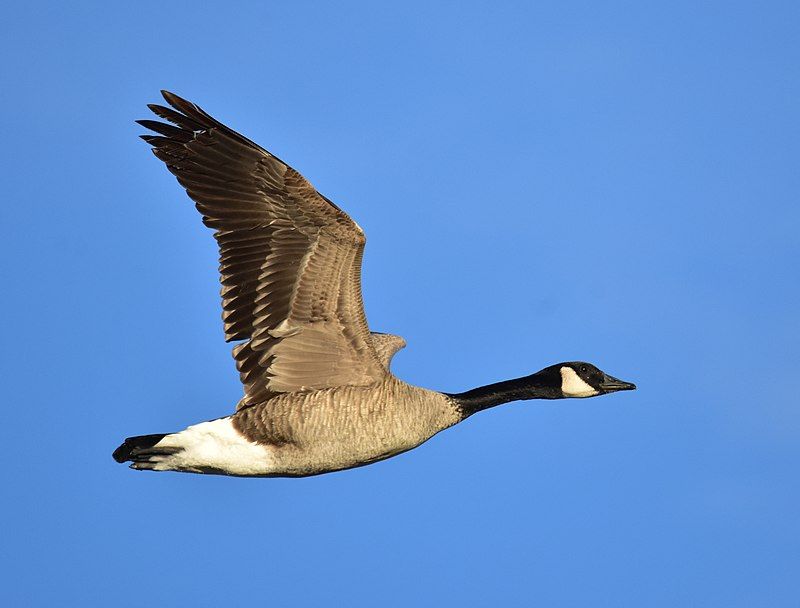
The Canada goose is a majestic bird that is native to the Arctic and temperate regions of North America. It is easily recognizable by its black head and neck, white cheeks, and brown body.
It can also be identified by its white chin, which stands out against its otherwise dark coloration. The Canada goose has a wide range of habitats, from the tundra and boreal forests of Canada to the lakes and marshes of the United States.
During the winter months, they migrate across the Atlantic, often reaching northern Europe. The Canada goose is a hardy bird that is capable of surviving in harsh conditions, and its impressive wingspan makes it an impressive sight in the sky.
It is an important species in the North American ecosystem, as it helps to control the populations of small animals and insects, and its droppings provide a valuable source of nutrients for the surrounding environment.
| Kingdom | Animalia |
| Phylum | Chordata |
| Class | Aves |
| Order | Anseriformes |
| Family | Anatidae |
| Genus | Branta |
| Species | B. canadensis |
20. Common Merganser
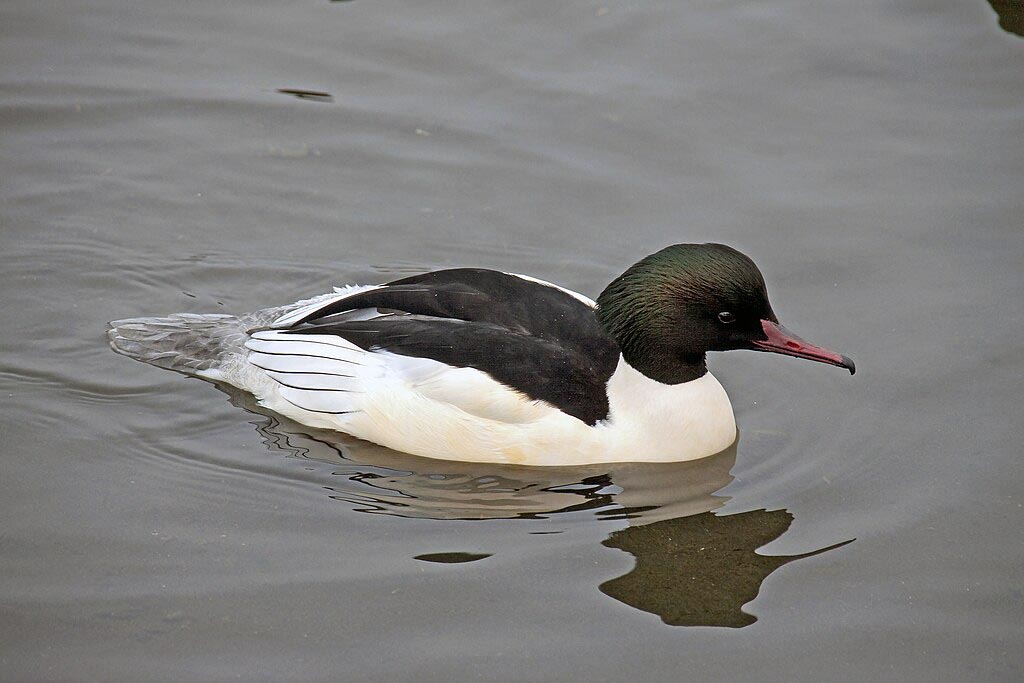
The common merganser, or goosander, is a large duck that inhabits the rivers and lakes of Europe, Asia, and North America. It is found in areas where there is significant forest cover, and it is an excellent swimmer, allowing it to navigate the waterways with relative ease.
This species primarily feeds on fish, making it an important top predator in the aquatic food web. The common merganser also nests in holes in trees. This species often chooses to nest in already existing cavities, such as those created by woodpeckers or squirrels.
The holes provide the ducklings with a safe and warm location to develop and grow.
The nesting location also offers protection from potential predators, such as large birds of prey, which have difficulty accessing the cavities. The common merganser is an important species to the ecology of its range.
It is a top predator in the aquatic food web, helping to keep fish populations in check. Additionally, the species helps to create and maintain nesting cavities, which can be used by other species. Overall, the common merganser is a vital part of its environment.
| Kingdom | Animalia |
| Phylum | Chordata |
| Class | Aves |
| Order | Anseriformes |
| Family | Anatidae |
| Genus | Mergus |
| Species | M. merganser |
21. Brown Creeper
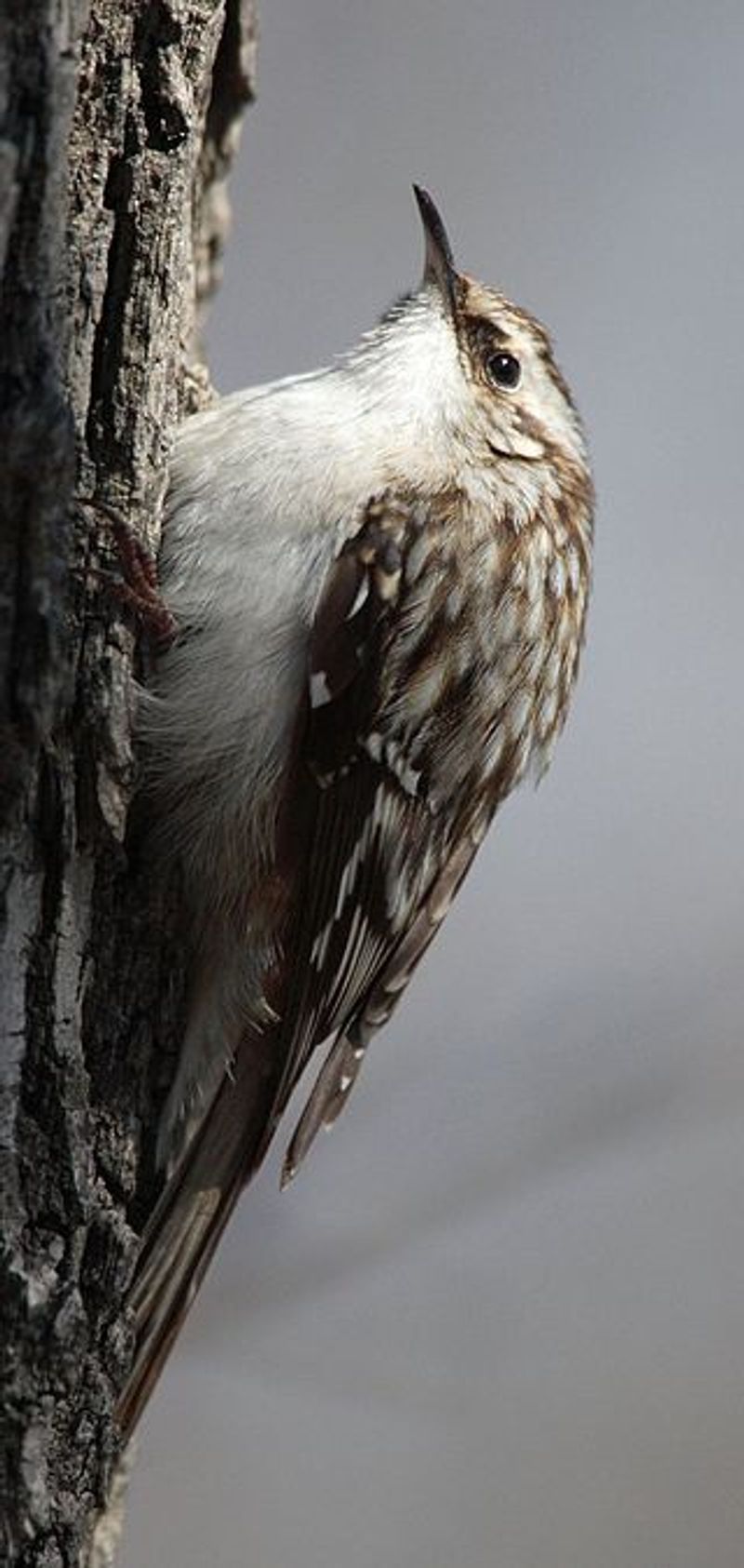
The brown creeper is a small songbird native to North America. It is the only North American member of the treecreeper family Certhiidae.
This bird is also known as the American treecreeper due to its behavior of creeping along the trunks of trees in search of insects and spiders. The brown creeper has a small, slender body and is about 5-6 inches in length.
Its upperparts are brown and its underparts are white with faint striping. Its wings have white spots, and its tail is long and narrow.
It has a curved bill which it uses to probe into crevices in trees and bark for food. The brown creeper is a solitary bird, but will sometimes form small flocks during the winter months. It has a soft, warbling song that is often heard in the early morning and late afternoon.
Its diet consists mainly of insects, spiders, and other arthropods. It is able to cling to the trunks of trees using its claws and use its curved bill to search for food. The brown creeper is found in deciduous and coniferous forests throughout much of North America.
It is a migratory species, and during the winter months, it moves southward to warmer climates. Its population numbers have been declining in recent years due to habitat loss and fragmentation. Conservation efforts are underway to protect this species and its habitat.
| Kingdom | Animalia |
| Phylum | Chordata |
| Class | Aves |
| Order | Passeriformes |
| Family | Certhiidae |
| Genus | Certhia |
| Species | C. americana |
22. Black-Headed Grosbeak
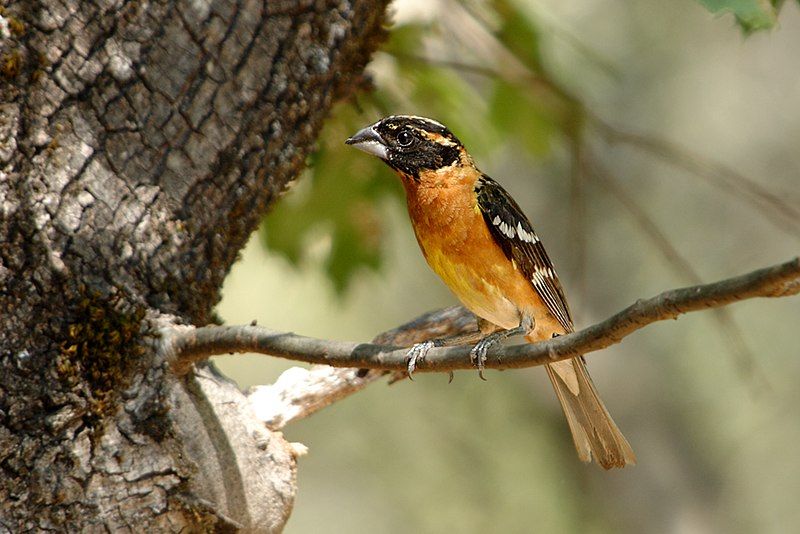
The black-headed grosbeak is a bird species that belongs to the family Cardinalidae, which is also known as the cardinal family. This species is medium-sized and primarily feeds on seeds.
It is closely related to the rose-breasted grosbeak and the two species have been known to hybridize on the American Great Plains. Hybridization occurs when two distinct species interbreed and create a new offspring that displays characteristics from both species.
It is likely that the hybridization of the black-headed and rose-breasted grosbeaks is due to their close proximity to one another in the same geographic region. Hybridization has become increasingly common in birds, especially in areas where their ranges overlap.
As such, the black-headed and rose-breasted grosbeaks are sometimes considered to be the same species due to their ability to interbreed on the American Great Plains.
| Kingdom | Animalia |
| Phylum | Chordata |
| Class | Aves |
| Order | Passeriformes |
| Family | Cardinalidae |
| Genus | Pheucticus |
| Species | P. melanocephalus |
23. Cinnamon Teal
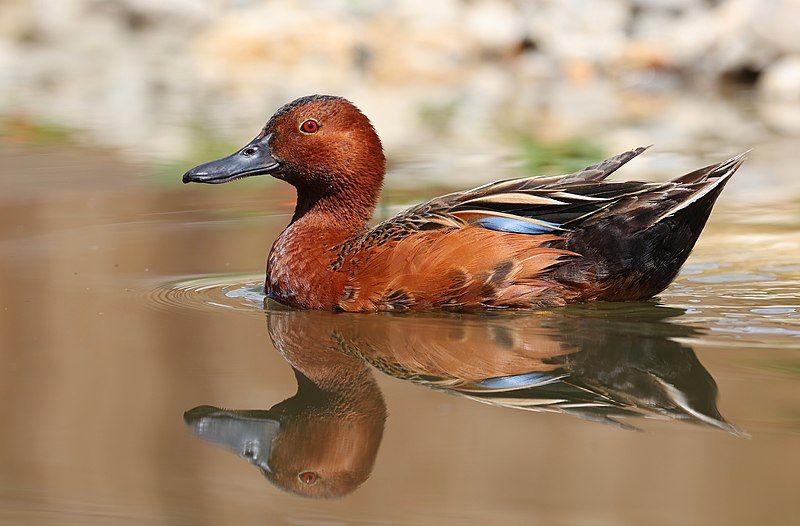
The Cinnamon Teal is a type of duck that is native to western North and South America. It is a small dabbling duck, meaning that it prefers to feed close to the surface of the water. The male Cinnamon Teal has bright reddish plumage, while the female is duller and browner.
This species of duck can be found in marshlands and ponds and feeds mostly on aquatic plants. It is an important food source for many predators like hawks, owls, and coyotes.
The Cinnamon Teal is also a popular target for birdwatchers, as it is one of the most colorful ducks in the United States. Its unique plumage and behavior make it a must-see for those interested in birding.
All in all, the Cinnamon Teal is an important part of the North and South American ecosystems, and its presence is both enjoyable and essential.
| Kingdom | Animalia |
| Phylum | Chordata |
| Class | Aves |
| Order | Anseriformes |
| Family | Anatidae |
| Genus | Spatula |
| Species | S. cyanoptera |
24. Sooty Grouse
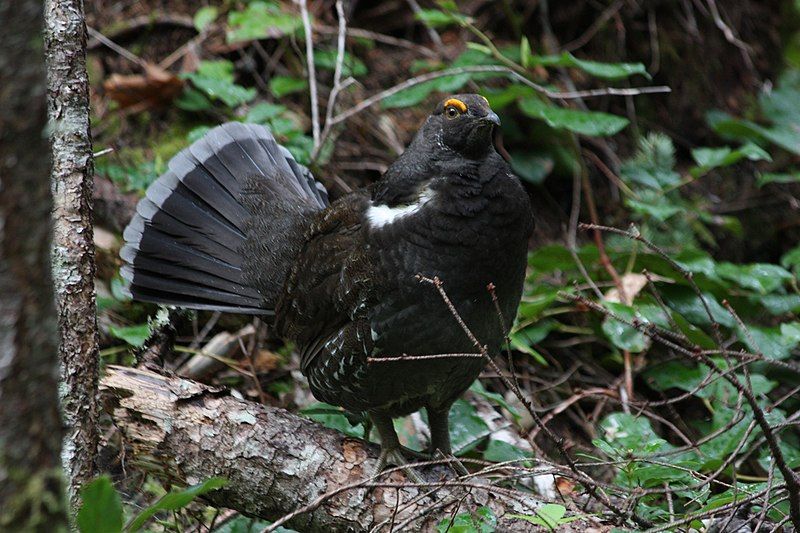
The sooty grouse is a species of forest-dwelling game bird that is found mainly in the Pacific Coast Ranges of North America. It is closely related to the dusky grouse, with the two species previously being thought of as a single species known as the blue grouse.
The sooty grouse is a medium-sized bird, with males typically weighing between 600-800 grams and females between 500-600 grams. Its plumage is generally a mottled gray-brown color, while its face and neck are generally darker in color.
The sooty grouse is a ground-dwelling species and lives in higher-elevation coniferous forests, where it feeds on a variety of plants and insects.
It is an important game species in many parts of its range and is also valued for its unique role in the ecosystems of the Pacific Coast Ranges.
| Kingdom | Animalia |
| Phylum | Chordata |
| Class | Aves |
| Order | Galliformes |
| Family | Phasianidae |
| Genus | Dendragapus |
| Species | D. fuliginosus |
Conclusion
Birds in South Lake Tahoe are varied and abundant, ranging from migratory waterfowl species to permanent residents. Birders of all levels of experience can find many species to observe in the area.
With its wide variety of habitats, South Lake Tahoe is a great place to view birds. Whether you are a beginner or an experienced birder, you can enjoy the beauty of the birds in South Lake Tahoe.